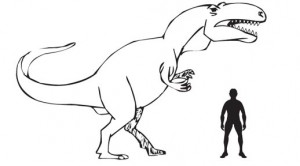Rare Dinosaur Footprints go on Display
Dinosaur Footprints Go on Display in Oxfordshire
Fossilised dinosaur trackways (dinosaur footprints) discovered at a landfill site north of Oxford have gone on display at a new exhibit at the Oxfordshire Museum in Woodstock (Oxon). The trackways, one of a theropod (meat-eating, bipedal dinosaur), the second, a set of prints from a large, quadruped herbivore (a sauropod) had to be moved to protect them and now make up a new “Dinosaur” themed garden at the museum.
Dinosaur Footprints
The tracks were discovered at the nearby Ardley quarry and landfill site in 1997, team members at Everything Dinosaur reported on the tricky problems of transporting the limestone rock slabs containing the fossilised footprints in an article written last year:
To read the article: Megalosaurus Makes its Mark.
Scientists believe that the trackways date to the Middle Jurassic and are approximately 160-170 million years old (Aalenian to Bajocian faunal stages), a time when much of southern England was a tropical paradise.
Commenting on the opening of the Dinosaur Garden, Tom Freshwater, of the museum sated:
“The footprints are very ephemeral remains that you get from dinosaurs, usually people think of bones”.
Trace Fossils
Footprints and trackways are trace fossils. Trace fossils preserve evidence of the activity of animals and other organisms. Unlike body fossils such as bones, most trace fossils are direct evidence of the environment at the time and place the organism existed. The dinosaur trackways, reveal information about the environment and ecosystem of the mid Jurassic.
To view the model of Megalosaurus and other dinosaurs: Dinosaur Models.
The theropod trackways are particularly interesting, as the space between the prints increases part of the way along the track. This is an indication that the animal changed its velocity – it broke out into a run.
Tom Freshwater went onto add:
“We’re very lucky that these fleeting momentary impressions have been preserved. The trackways at Ardley showed the dinosaurs running and that’s very rare thing. They’re the longest trackways in the world showing dinosaurs running. So that’s why they’re so important.”
Theropod Tracks
Although scientists cannot be sure, it is believed that the theropod tracks were made by a Megalosaurus, a fierce, carnivorous dinosaur, fossils of which are associated with this area and rock strata.
An Illustration of a Megalosaurus Footprint

Picture credit: Everything Dinosaur
European Carnivorous Dinosaurs
Very little is known about European meat-eating dinosaurs of the Jurassic due to the paucity of the fossil record, although Megalosaurus does have the distinction of being the first dinosaur to be studied scientifically and named.
An Illustration of Megalosaurus
Picture credit: Everything Dinosaur
The carefully re-created “Dinosaur” themed garden depicts a Megalosaurus and contains typical plants that would have comprised part of the flora of the environment at the time the Megalosaurus roamed Oxfordshire.
The sauropod tracks have been ascribed to a Cetiosaurus, a long-necked dinosaur and primitive member of the sauropod group. It is not known whether the megalosaur was stalking the Cetiosaurus. Interestingly, Cetiosaurus was one of the first sauropods to be formerly named and described (Sir Richard Owen, 1842). As well as sharing the limelight at the Oxfordshire Museum with Megalosaurus, Cetiosaurus has another thing in common with its meat-eating contemporary.
For a long time after Megalosaurus and Cetiosaurus were discovered any fossil remains of a carnivore or long-necked herbivore were ascribed to these genera. They became known as “taxon wastebaskets”. Only with further study and more fossil material has the megalosaur/cetiosaur muddle begun to be unravelled.


